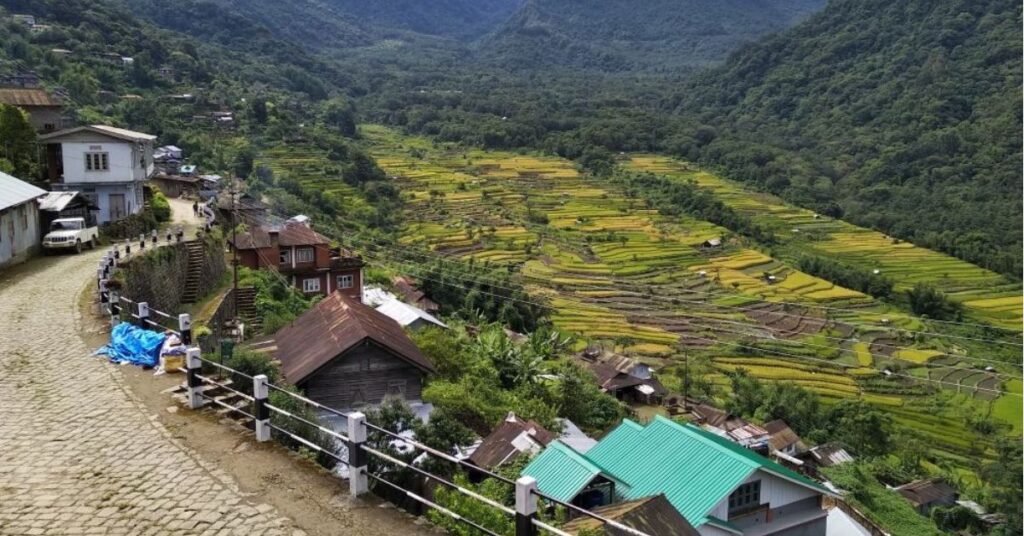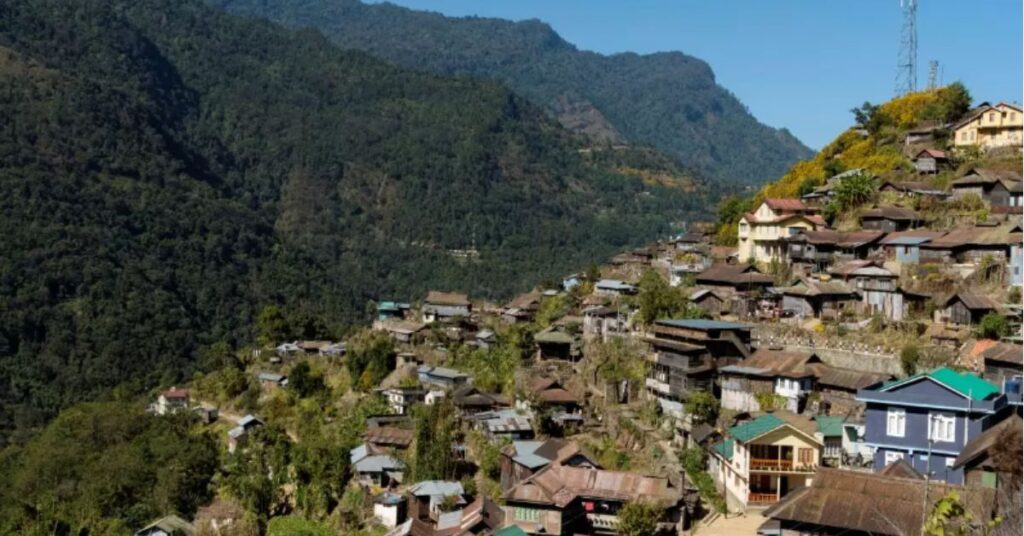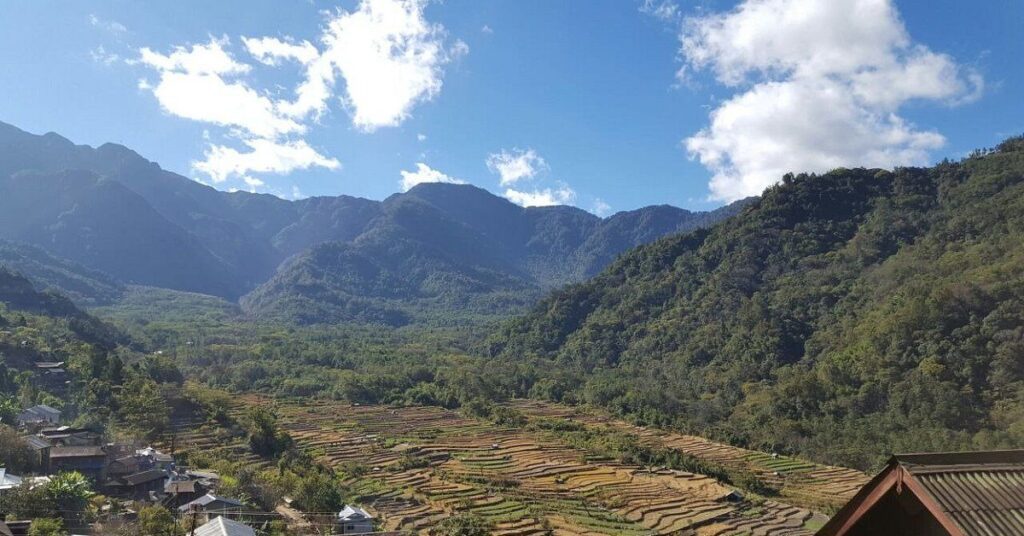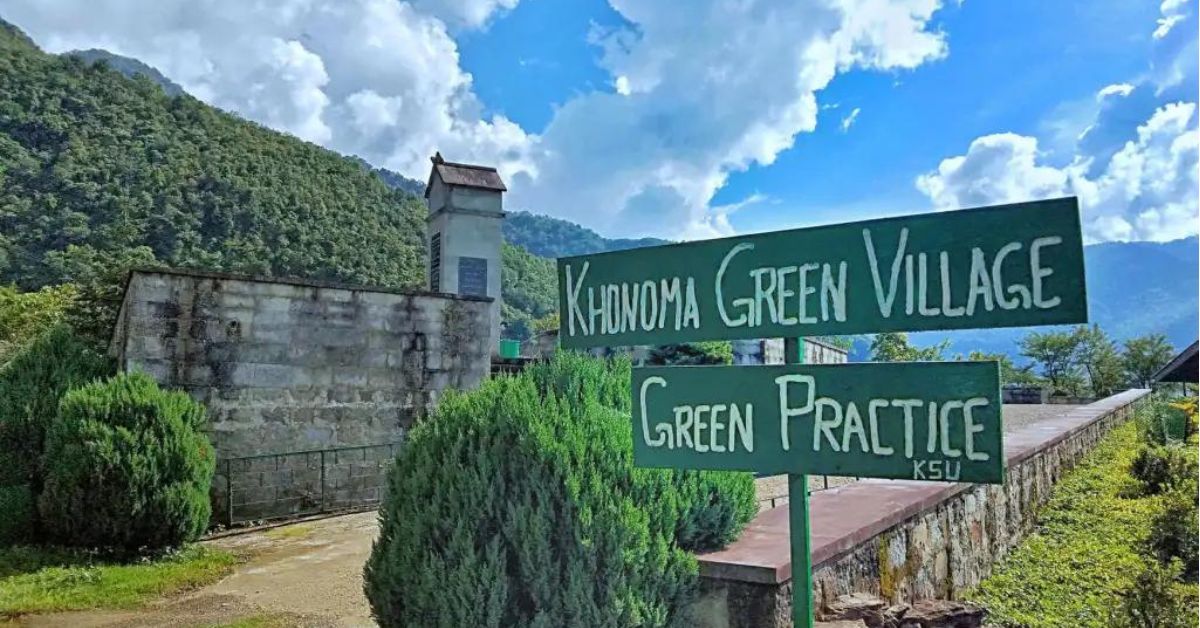Tucked away in Nagaland’s beautiful hills, Khonoma Green Village shines brightly as a champion for both nature and tradition. This friendly community is famous for taking care of the environment and keeping Naga ways alive, making it one of India’s greenest villages. Here, you’ll find a rare chance to experience ancient customs alongside a modern respect for the Earth.
Khonoma isn’t just a pretty picture (though it is that too!), it’s a real-life example of how old traditions and protecting the environment can go hand-in-hand. Located about 20 kilometers from Kohima, the village is a standout for eco-tourism because of its clever ways to conserve nature, like community projects to safeguard the forests and wild animals.
How to reach:
By Air:
Dimapur Airport (DMU) is your landing spot, about 74 kilometers from Khonoma. Once you touch down, grab a taxi or shared cab to Kohima. From Kohima, another taxi or shared cab will whisk you to the green village – the entire trip takes roughly 2-3 hours.
By Train:
Dimapur Railway Station is the closest major train station, again 74 kilometers away. From here, taxis and shared cabs are your best bet to reach Kohima. Then, hop on another one to reach Khonoma. Expect a 2-3 hour ride from Dimapur to Kohima, with the final leg to Khonoma taking about 30-45 minutes.
By Road:
Khonoma is easily accessible by road from Kohima. Taxis and shared cabs are readily available for the scenic 30-45 minute drive.
Exploring the Broader Region:
Coming from other Northeast Indian cities? Just get to Kohima by bus or taxi, and then continue on to Khonoma. Many travel operators offer rides to Kohima, and from there, local transport options are plentiful.
Best time to visit:
Cool and Clear (November-March):
- Perfect Weather: Embrace comfortable temperatures (10°C to 25°C) ideal for exploring the village and outdoor activities.
- Crystal Clear Skies: Witness breathtaking vistas of the surrounding hills and landscapes.
- Festival Fun: Immerse yourself in the vibrant culture with traditional Naga festivals and community events.
Monsoon Magic (June-September):
- Emerald Embrace: Witness Khonoma at its most verdant, with lush vegetation thriving under the monsoon rains. Be prepared for potential mud!
- Peaceful Escape: Enjoy a more tranquil experience with potentially fewer visitors during this season.
- Plan Wisely: Be aware of potential landslides and ensure roads are passable before your trip.
Pleasant Transitions (April-May & October):
- Mild Delights: Experience comfortable weather as the seasons shift, with neither extreme heat nor cold.
- Potential Blooms: Witness the possibility of early or late blooms depending on the exact timing of your visit.
attractions:
Khonoma Nature Conservation and Tragopan Sanctuary:

Khonoma Nature Conservation and Tragopan Sanctuary isn’t just a pretty place, it’s a symbol of Khonoma’s dedication to protecting the environment. Founded to save the rare Blyth’s Tragopan, a pheasant local to the area, this sanctuary boasts rolling hills and lush green forests. It’s a haven for plants and wildlife, making it a paradise for nature lovers and birdwatchers.
Imagine trekking through dense forest trails with a guide, hoping to catch a glimpse of the elusive Tragopan or other fascinating birds. The sanctuary is also a learning center, where you can discover Khonoma’s incredible conservation efforts and how they balance human needs with protecting wildlife. By visiting, you’re supporting these initiatives that keep the region naturally beautiful and healthy.
Khonoma Village:

Khonoma Nature Conservation and Tragopan Sanctuary transcends scenic beauty, standing as a symbol of Khonoma’s unwavering commitment to environmental protection. Established to safeguard the endangered Blyth’s Tragopan, a local pheasant, the sanctuary boasts rolling hills and verdant forests teeming with life. This haven for diverse plants and wildlife makes it a paradise for nature enthusiasts and birdwatchers. Imagine trekking through dense forest trails with a guide, anticipation building as you hope to spot the elusive Tragopan or other fascinating birds. The sanctuary doubles as a learning center, offering insights into Khonoma’s remarkable conservation efforts and their success in balancing human needs with wildlife protection. By visiting, you become a part of this ongoing mission, supporting initiatives that keep the region’s natural beauty and ecological health thriving.
Japfu Peak, Khonoma Green Village:

Nestled close to Khonoma, Dzükou Valley isn’t just any valley – it’s a real-life flower wonderland, often called the “valley of flowers.” This breathtaking spot sits up high in the mountains, with rolling hills covered in lush green meadows bursting with colorful wildflowers. The clear blue sky and fresh mountain air make it feel untouched, a perfect escape for trekkers and nature lovers. Imagine hiking along scenic trails, taking in gorgeous views of mountains and valleys all around. During the blooming season, the valley comes alive with a riot of colors, making it a photographer’s dream and a place to simply relax and soak it all in. If you’re looking for a peaceful escape from the city noise, Dzükou Valley’s serene beauty and natural magic are the perfect answer.
local lexperiences:
Tantalize Your Taste Buds: Savor authentic Naga cuisine – smoked pork, bamboo shoot curry, and rice beer – prepared using age-old methods in the village.
Immerse in Culture: Witness vibrant dances, music, and rituals at local festivals and events. Gain a deep understanding of Naga traditions and community living.
Connect with the Community: Chat with villagers, learn about their daily routines, customs, and sustainable practices. Get a firsthand look at Naga life.
Explore Nature’s Bounty: Take guided walks through the village’s surroundings and nearby conservation areas. Discover local plants and animals, and understand Khonoma’s dedication to protecting the environment.
Become a Craft Master: Unleash your creativity in workshops on traditional Naga crafts like weaving, basket-making, and pottery. Take home a unique handmade souvenir!
Give Back to Nature: Join tree-planting initiatives or wildlife monitoring programs alongside the community. Contribute to local environmental efforts and learn sustainable practices.
Step Back in Time: Explore the village on foot, marveling at traditional bamboo houses and their unique architecture – a reflection of Naga heritage.
Adventure Awaits: Embark on treks to nearby gems like Dzükou Valley and Japfu Peak. Experience the region’s breathtaking beauty and enjoy outdoor thrills.
Shop Local: Find hidden treasures at local markets. Browse through Naga handicrafts, fresh produce, and indigenous products, supporting local artisans and farmers.
Embrace Eco-Tourism: Participate in experiences that highlight Khonoma’s commitment to sustainability. Join eco-friendly farming tours or participate in environmental education sessions.
Celebrate with the Locals: Immerse yourself in traditional ceremonies and festivals alongside the community. Experience Naga cultural heritage firsthand – a truly unique opportunity.
Capture the Moment: With your camera, freeze-frame the stunning landscapes, traditional village life, and the rich biodiversity of Khonoma. Observe the local wildlife in their natural habitat.
travel tips:
- Inner Line Permit (ILP): Secure an ILP, mandatory for entering Nagaland. Apply online or at designated offices in neighboring states. Foreigners might need to register with the Foreigner Registration Office too.
- Pre-plan Transportation: Arrange transport from Dimapur Airport or Railway Station to Kohima beforehand. From Kohima, taxis or shared cabs take you to Khonoma (30-45 minute drive).
- Dress for Comfort: Pack comfortable clothes suitable for the weather. Sturdy walking shoes are a must. Bring layers and a jacket for cooler months. Rain gear is essential during the monsoon.
- Respectful Attire: Dress modestly and seek permission before photographing people or private property. Be mindful of local customs for a positive experience.
- Limited Connectivity: Mobile network coverage can be patchy in Khonoma. Carry a portable charger and inform loved ones about potential connectivity issues.
- Support Eco-Tourism: Participate in eco-friendly initiatives and conservation projects. Follow local guidelines to minimize your environmental impact and promote sustainable tourism.
- Cash is King: ATMs might be limited or unavailable. Carry enough cash for purchases and local expenses, as card payments may not be widely accepted.
- Book Early: Reserve your accommodation in advance, especially during peak season or festivals, to secure availability and good rates.
- Be Weather-Ready: Check weather forecasts before your trip, especially if you plan outdoor activities. Roads can be slippery during the monsoon.
- Hydration & First-Aid: Drink plenty of water and carry a basic first-aid kit. Exercise caution with street food and unfamiliar dishes to avoid any digestive issues.
- Learn a Few Phrases: Learning basic phrases in the local Naga language enhances communication and shows respect for the local culture.
- Engage with the Community: Interact with villagers and participate in cultural activities to gain a deeper understanding of Naga traditions and way of life.
conclusion
Unveiling a hidden gem in Nagaland’s mountains, Khonoma Green Village offers an experience unlike any other. Here, environmental consciousness and rich cultural heritage intertwine, creating a unique tapestry for travelers. As a champion for sustainability, Khonoma seamlessly blends preserving its environment with celebrating traditional Naga practices. Explore the breathtaking landscapes of Dzükou Valley or conquer the majestic Japfu Peak for panoramic vistas. Immerse yourself in the vibrant local culture by savoring mouthwatering Naga cuisine and witnessing captivating cultural performances. Khonoma caters to nature lovers and cultural enthusiasts alike. But Khonoma goes beyond sightseeing – it’s about connecting with a community at the forefront of sustainable living. Let Xplro.com, your adventure partner, guide you on this unforgettable journey. We’ll help you navigate permits, plan transportation, and ensure a smooth and respectful visit. Explore our detailed guides and discover the best season to visit, must-try experiences, and hidden gems Khonoma Green Village has to offer. Khonoma awaits. Let Xplro.com be your compass!
faqs
What is the ideal time to visit Khonoma Green Village?
- The ideal time to visit Khonoma Green Village is between October and March. During these months, you can expect cool and pleasant weather, perfect for outdoor activities and exploring the village.
How can I reach Khonoma Green Village?
- To reach Khonoma Green Village, fly into Dimapur Airport or take a train to Dimapur Railway Station, located about 74 kilometers away. From Dimapur, you can hire a taxi to Kohima and then take another taxi or shared cab to Khonoma, which is approximately a 30-45 minute drive from Kohima.
Is a permit required to visit Khonoma Green Village?
- Yes, visitors need an Inner Line Permit (ILP) to enter Nagaland. You can obtain the ILP online or at designated offices in neighboring states. Foreign tourists may also need to register with the Foreigner Registration Office.
What should I pack for a visit to Khonoma Green Village?
- Pack comfortable clothes suitable for the weather and sturdy walking shoes. Bring layers for cooler evenings and rain gear if you’re traveling during the monsoon season. Also, consider carrying a portable charger and a basic first-aid kit.
Is it safe to visit Khonoma Green Village?
- Khonoma Green Village is generally safe for tourists. However, it’s best to travel with a guide or in groups, follow local guidelines, and be mindful of weather conditions, especially during the monsoon season.
What are the main attractions in Khonoma?
- Key attractions include the Khonoma Green Village’s Nature Conservation and Tragopan Sanctuary, Dzükou Valley, Japfu Peak, Khonoma War Cemetery, and traditional bamboo houses, each offering unique insights into the village’s natural and cultural heritage.
Are there places to stay in Khonoma Green Village?
- Yes, Khonoma Green Village offers various accommodations, such as guesthouses and homestays. It’s recommended to book your stay in advance, particularly during peak travel times or festivals.
Can I try local food in Khonoma Green Village?
- Yes, you can enjoy traditional Naga cuisine in Khonoma Green Village. Local eateries serve dishes like smoked pork, bamboo shoot curry, and rice beer, providing an authentic taste of Naga culinary traditions.
How do I get around Khonoma?
- You can use local transportation options, including taxis, auto-rickshaws, and rented scooters. Hiring a local taxi or guide can also be convenient for exploring the village and nearby attractions.
What activities can I do in Khonoma Green Village?
- Activities in Khonoma Green Village include exploring natural sites like Dzükou Valley and Japfu Peak, participating in eco-tourism initiatives, enjoying cultural performances, and taking part in traditional craft workshops.
What is mobile network coverage like in Khonoma Green Village?
- Mobile network coverage in Khonoma Green Village may be limited, especially in remote areas. It’s wise to carry a portable charger and inform family or friends about possible connectivity issues.
Are there any cultural practices I should be aware of when visiting Khonoma Green Village?
- Dress modestly and ask for permission before taking photos of people or private property. Show respect for local customs and traditions, and support eco-friendly tourism practices to ensure a positive experience.






